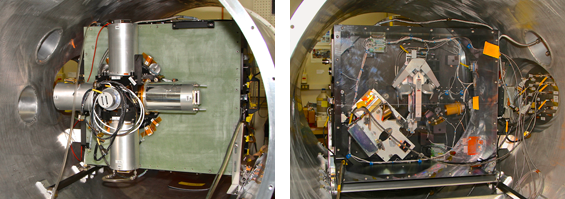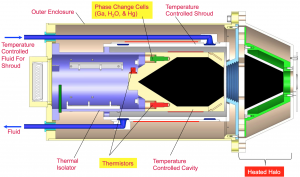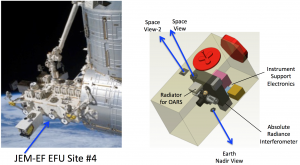Benchmarking the Earth’s Climate from Space: SSEC’s IR Instrument Prototype Ready for Flight
Developing new satellite instrument technology often takes years of hard work, not to mention perseverance. Despite all the possible bumps in the development path, the end goal always is to see the concept become a reality, orbiting the Earth and operating as designed.
In September 2013, SSEC researchers reached an important milestone, bringing them one step (or, in this case, a giant leap) closer to fulfilling that goal when their instrument called the Absolute Radiance Interferometer (ARI) was declared ready for a spaceflight opportunity by NASA’s Earth Science Technology Office. ARI had successfully completed rigorous thermal vacuum testing, operating in simulated space-like conditions.

The Absolute Radiance Interferometer (ARI) in a vacuum chamber. Above left, the front-end of the instrument is shown with two calibration blackbodies, the On-Orbit Absolute Radiance Standard, and a simulated Earth scene blackbody. Above right, the back-end of the instrument includes the interferometer that provides spectral splitting.
SSEC’s Director Hank Revercomb and Executive Director for Technology Fred Best are optimistic that SSEC’s efforts on ARI will lead to an opportunity to demonstrate the instrument and its new technologies in space, perhaps on the International Space Station (ISS). Revercomb noted that the expected lifetime of the space station has recently been extended to 2024. This extension would inevitably lead to additional opportunities for spaceflight-ready experiments, added Best.
What makes ARI a particularly attractive option for the space station is that SSEC has already designed and built a successful prototype. Revercomb does not foresee any issues with developing an ARI to fly on board the ISS. He asserted that, “We’ve eliminated essentially all of the fundamental questions of being able to do this. From the start we tried to make it as close to a flight prototype as possible.”
That start noted by Revercomb was more than seven years ago and began with the release of the National Research Council 2007 Decadal Survey. Specifically, SSEC worked with Jim Anderson of Harvard to define a satellite mission known as the Climate Absolute Radiance and Refractivity Observatory (CLARREO), which was recommended in the survey as a Tier 1 mission – meaning that it was important and recommended for development; CLARREO was one of four such missions. Designed to create a benchmark for climate measurements, CLARREO consists of three instruments: infrared (IR), solar, and Global Positioning System/Radio Occultation (GPS/RO). Revercomb described ARI as “a prototype for what’s needed for the IR portion of CLARREO.”
In collaboration with Harvard, SSEC developed the ARI through NASA’s Instrument Incubator Program, which supported technology development for the decadal survey missions. However, Best remarked that the initial concept for one of ARI’s new technologies, the phase change cells used for absolute temperature calibration, was funded under internal seed funding.
For CLARREO accuracy requirements are very strict. SSEC engineers were aiming to meet a tenth of a degree (Kelvin) three sigma absolute accuracy. According to Revercomb, “It’s unique to have that level of accuracy, but what really makes it stand apart is that it can be verified on orbit. The new technologies that we developed here allow you to do that testing on orbit.”
Revercomb noted there are “three basic categories that our technologies fall into: ones that test radiometric accuracy, ones that test spectral properties, and ones that are diagnostic.”

The On-orbit Absolute Radiance Standard (OARS), including miniature phase change cells that provide absolute temperature calibration and the heated halo for measurement of the cavity emissivity.
Specifically, the key new technologies for on-orbit verification are:
- On-orbit Absolute Radiance Standard (OARS), a high emissivity blackbody cavity;
- Absolute temperature calibration using phase change cells;
- Blackbody emissivity measurements using a heated halo;
- On-orbit instrument spectral response measurement using a CO2 laser; and
- Blackbody emissivity and spectral response measurements using a quantum cascade laser.
The first three technologies were developed at SSEC while the last two were developed at Harvard. Initially, each technology began as a concept and was individually advanced to a mature level. The interferometer was developed in a similar manner with a number of maturity milestones met along the way. In the end, Best stated, “we integrated all those technologies into a prototype instrument and demonstrated the required performance in a space-like environment of a vacuum in a presence of expected on-orbit temperature fluctuations.”
That fully functional and tested prototype now awaits an opportunity to fly. Clearly proud of their team’s achievement, Revercomb and Best are eager to find that opportunity and demonstrate what ARI can do, especially given the fact that the CLARREO mission has been delayed indefinitely, with a launch no sooner than 2023. Revercomb described a technical demonstration of the ARI on the space station as “the best way to move forward.” Even more promising is that a prototype of the solar instrument for CLARREO is also ready, meaning that two of the major CLARREO instruments could conceivably fly on the space station.
However, this opportunity would serve as more than just a technical demonstration. Revercomb noted that it would provide a head start on CLARREO’s science goals by using the data for intercalibration studies, focusing on IR sounders already in orbit – the Atmospheric InfraRed Sounder (AIRS), Infrared Atmospheric Sounding Interferometer (IASI), and Cross-track Infrared Sounder (CrIS) – and working toward unifying the data records so that they will be useful for climate research. “This would be a technology demonstration, but one that actually stands a very high probability of starting the benchmark measurements of CLARREO,” he said.
Whatever happens, the work continues. Not only do these new technologies have applications beyond CLARREO, but also, as Revercomb and Best pointed out, SSEC Engineer Joe Taylor has just completed his PhD through Laval University in Canada based on his ARI-related efforts. He successfully defended his dissertation in early July – yet another major milestone in ARI’s development path.
by Leanne Avila

